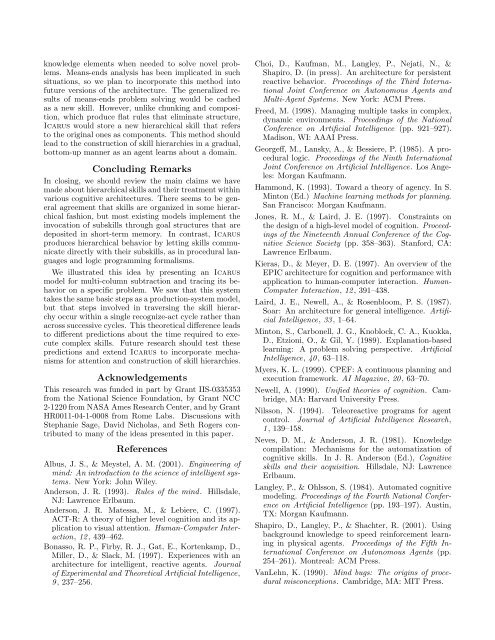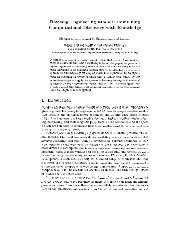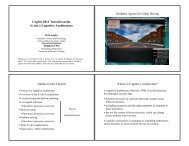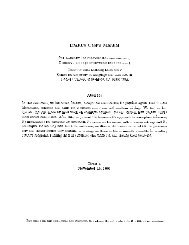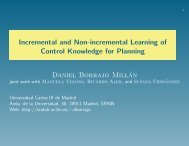Hierarchical Skills and Cognitive Architectures - Computational ...
Hierarchical Skills and Cognitive Architectures - Computational ...
Hierarchical Skills and Cognitive Architectures - Computational ...
Create successful ePaper yourself
Turn your PDF publications into a flip-book with our unique Google optimized e-Paper software.
knowledge elements when needed to solve novel problems.<br />
Means-ends analysis has been implicated in such<br />
situations, so we plan to incorporate this method into<br />
future versions of the architecture. The generalized results<br />
of means-ends problem solving would be cached<br />
as a new skill. However, unlike chunking <strong>and</strong> composition,<br />
which produce flat rules that eliminate structure,<br />
Icarus would store a new hierarchical skill that refers<br />
to the original ones as components. This method should<br />
lead to the construction of skill hierarchies in a gradual,<br />
bottom-up manner as an agent learns about a domain.<br />
Concluding Remarks<br />
In closing, we should review the main claims we have<br />
made about hierarchical skills <strong>and</strong> their treatment within<br />
various cognitive architectures. There seems to be general<br />
agreement that skills are organized in some hierarchical<br />
fashion, but most existing models implement the<br />
invocation of subskills through goal structures that are<br />
deposited in short-term memory. In contrast, Icarus<br />
produces hierarchical behavior by letting skills communicate<br />
directly with their subskills, as in procedural languages<br />
<strong>and</strong> logic programming formalisms.<br />
We illustrated this idea by presenting an Icarus<br />
model for multi-column subtraction <strong>and</strong> tracing its behavior<br />
on a specific problem. We saw that this system<br />
takes the same basic steps as a production-system model,<br />
but that steps involved in traversing the skill hierarchy<br />
occur within a single recognize-act cycle rather than<br />
across successive cycles. This theoretical difference leads<br />
to different predictions about the time required to execute<br />
complex skills. Future research should test these<br />
predictions <strong>and</strong> extend Icarus to incorporate mechanisms<br />
for attention <strong>and</strong> construction of skill hierarchies.<br />
Acknowledgements<br />
This research was funded in part by Grant IIS-0335353<br />
from the National Science Foundation, by Grant NCC<br />
2-1220 from NASA Ames Research Center, <strong>and</strong> by Grant<br />
HR0011-04-1-0008 from Rome Labs. Discussions with<br />
Stephanie Sage, David Nicholas, <strong>and</strong> Seth Rogers contributed<br />
to many of the ideas presented in this paper.<br />
References<br />
Albus, J. S., & Meystel, A. M. (2001). Engineering of<br />
mind: An introduction to the science of intelligent systems.<br />
New York: John Wiley.<br />
Anderson, J. R. (1993). Rules of the mind. Hillsdale,<br />
NJ: Lawrence Erlbaum.<br />
Anderson, J. R. Matessa, M., & Lebiere, C. (1997).<br />
ACT-R: A theory of higher level cognition <strong>and</strong> its application<br />
to visual attention. Human-Computer Interaction,<br />
12, 439–462.<br />
Bonasso, R. P., Firby, R. J., Gat, E., Kortenkamp, D.,<br />
Miller, D., & Slack, M. (1997). Experiences with an<br />
architecture for intelligent, reactive agents. Journal<br />
of Experimental <strong>and</strong> Theoretical Artificial Intelligence,<br />
9, 237–256.<br />
Choi, D., Kaufman, M., Langley, P., Nejati, N., &<br />
Shapiro, D. (in press). An architecture for persistent<br />
reactive behavior. Proceedings of the Third International<br />
Joint Conference on Autonomous Agents <strong>and</strong><br />
Multi-Agent Systems. New York: ACM Press.<br />
Freed, M. (1998). Managing multiple tasks in complex,<br />
dynamic environments. Proceedings of the National<br />
Conference on Artificial Intelligence (pp. 921–927).<br />
Madison, WI: AAAI Press.<br />
Georgeff, M., Lansky, A., & Bessiere, P. (1985). A procedural<br />
logic. Proceedings of the Ninth International<br />
Joint Conference on Artificial Intelligence. Los Angeles:<br />
Morgan Kaufmann.<br />
Hammond, K. (1993). Toward a theory of agency. In S.<br />
Minton (Ed.) Machine learning methods for planning.<br />
San Francisco: Morgan Kaufmann.<br />
Jones, R. M., & Laird, J. E. (1997). Constraints on<br />
the design of a high-level model of cognition. Proceedings<br />
of the Nineteenth Annual Conference of the <strong>Cognitive</strong><br />
Science Society (pp. 358–363). Stanford, CA:<br />
Lawrence Erlbaum.<br />
Kieras, D., & Meyer, D. E. (1997). An overview of the<br />
EPIC architecture for cognition <strong>and</strong> performance with<br />
application to human-computer interaction. Human-<br />
Computer Interaction, 12, 391–438.<br />
Laird, J. E., Newell, A., & Rosenbloom, P. S. (1987).<br />
Soar: An architecture for general intelligence. Artificial<br />
Intelligence, 33, 1–64.<br />
Minton, S., Carbonell, J. G., Knoblock, C. A., Kuokka,<br />
D., Etzioni, O., & Gil, Y. (1989). Explanation-based<br />
learning: A problem solving perspective. Artificial<br />
Intelligence, 40, 63–118.<br />
Myers, K. L. (1999). CPEF: A continuous planning <strong>and</strong><br />
execution framework. AI Magazine, 20, 63–70.<br />
Newell, A. (1990). Unified theories of cognition. Cambridge,<br />
MA: Harvard University Press.<br />
Nilsson, N. (1994). Teleoreactive programs for agent<br />
control. Journal of Artificial Intelligence Research,<br />
1, 139–158.<br />
Neves, D. M., & Anderson, J. R. (1981). Knowledge<br />
compilation: Mechanisms for the automatization of<br />
cognitive skills. In J. R. Anderson (Ed.), <strong>Cognitive</strong><br />
skills <strong>and</strong> their acquisition. Hillsdale, NJ: Lawrence<br />
Erlbaum.<br />
Langley, P., & Ohlsson, S. (1984). Automated cognitive<br />
modeling. Proceedings of the Fourth National Conference<br />
on Artificial Intelligence (pp. 193–197). Austin,<br />
TX: Morgan Kaufmann.<br />
Shapiro, D., Langley, P., & Shachter, R. (2001). Using<br />
background knowledge to speed reinforcement learning<br />
in physical agents. Proceedings of the Fifth International<br />
Conference on Autonomous Agents (pp.<br />
254–261). Montreal: ACM Press.<br />
VanLehn, K. (1990). Mind bugs: The origins of procedural<br />
misconceptions. Cambridge, MA: MIT Press.


